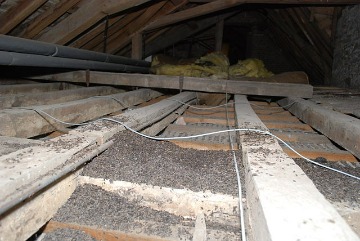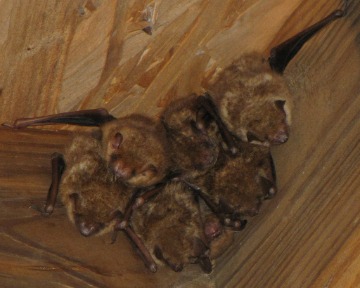Attic Bat Removal Butler, Indiana
Contents
Do you need an experienced Butler bat removal company? Although having bats in your house can be a frightening experience, our DeKalb County, IN staff is well-versed in laws and regulations for bat removal and will take all necessary precautions to ensure the safety of your family as well as the bats in the attic. In order to avoid spreading disease, bats must be handled with utmost caution, necessitating the use of an expert bat removal service.

3 Top Dangers of Bats in the Attic
Whether you have a single brown bat or an entire colony of bats in the attic, bats present dangers and you’ll want to get rid of bats quickly. Bats in Butler are known to cause on average, several thousand dollars in removal and restoration costs.
- Physical Damage:The continual buildup of guano and urine from attic bats roosting damages attic insulation and even drywall. It’s possible that your homeowners insurance will deny this structural damage to your property, leaving you with expensive repair costs.
- Rabies: In addition, if a person has been sleeping in an area where a bat was flying around, the bat should be brought in and tested for rabies. Never handle or attempt to grab a bat yourself! Unfortunately, the fatality rate for bat bites and scratches is 100% without proper vaccination within 14 days after exposure. For more information visit the DeKalb County Indiana website rabies information page.
- Histoplasmosis: Inhalation of fungal spores present in bat guano causes this disease. When bats roost in the attic, they leave large volumes of droppings, which can spread disease. Another reason to avoid sweeping up bat poop is that doing so can disperse spores.
Humane Butler Bat Exclusion Services
- First, we look for possible entry points for bats around the outside of your house.
- After that, we place one-way excluder valves that permit the bats to exit, but prevent them from returning.
- Finally, we clean up the droppings left behind by the bats and seal the entire home off permanently.
From A to Z, we take care of all bat infestation issues. We are a full service bat control service in Butler, Indiana meaning we handle removal, guano clean up, sanitizing and attic restoration.
Can bat guano kill you?

Bats become a nuisance when they roost in large numbers in human dwellings. The rapid accumulation of guano (bat droppings) is unsanitary, and serves as a fertile breeding ground for a fungal disease called Histoplasmosis, which is transferable to humans who breathe in the fungal spores.
What happens if you have bats? It is illegal to intentionally kill, injure or take any bat or to recklessly damage, destroy or block up their roosts or disturb them. Because bats tend to return to the same roosts each year, these sites are protected whether the bats are present or not.
What happens if you have bats? It is illegal to intentionally kill, injure or take any bat or to recklessly damage, destroy or block up their roosts or disturb them. Because bats tend to return to the same roosts each year, these sites are protected whether the bats are present or not.
Is it dangerous to have bats in your house? Bats can also damage your home. They can chew into walls, damage insulation or damage wiring as well. Bat guano is a carrier of the fungus histoplasma capsulatum. Another serious risk from bats, although rare, is the possibility of a bat transmitting rabies to a human from a bite.
Can bats poop while flying?

How long does a bat live? Between 20 and 40 years. Compared to a similar-sized animal like a rat that lives only two or three years, bats live between 20 and 40 years. Researchers theorize this has to do with the ability of bats to fly.
What does bat pee smell like? Bat excrement produces an unpleasant odor as it decomposes in attics, wall spaces, and other voids. The pungent, musty, acrid odor can often be detected from outside a building containing a large or long-term colony.
Do bat droppings look like?

Are bats attracted to light at night time? It is well established that bats are sensitive to light while hunting at night. While some species are attracted to artificial light sources because of the insects nearby, most bat species generally avoid artificial light.
How long does a bat live? Between 20 and 40 years. Compared to a similar-sized animal like a rat that lives only two or three years, bats live between 20 and 40 years. Researchers theorize this has to do with the ability of bats to fly.
How big of a crack can a bat fit through? Their small size makes it easy for bats to tuck themselves into even the smallest of gaps. They can squeeze through holes as small as 6 millimetres or about the size of a dime. Once inside the structure, bats will roost in attics and between walls.
Why are bats important? By eating insects, bats save U.S. agriculture billions of dollars per year in pest control. Some studies have estimated that service to be worth over $3.7 billion per year, and possibly as much as $53 billion. This value does not, however, take into account the volume of insects eaten by bats in forest ecosystems. U.S. Department of the Interior
Can bat droppings cause disease?

What to look for in a bat removal company
- Always perform a proper live exclusion.
- Never use poisons or fumigants or kill bats.
- Never use traps or attempt to relocate bats.
- Never do a removal during the maternity season.
- Seal all entry points shut with guarantee.
- Offer attic cleanup and decontamination.
- Properly licensed by the Indiana DNR and insured.
How do I bat proof my house? Use window screens, chimney caps, and draft-guards beneath doors to attics, fill electrical and plumbing holes with stainless steel wool or caulking, and ensure that all doors to the outside close tightly. Prevent bats from roosting in attics or buildings by covering outside entry points. CDC Bat Management

